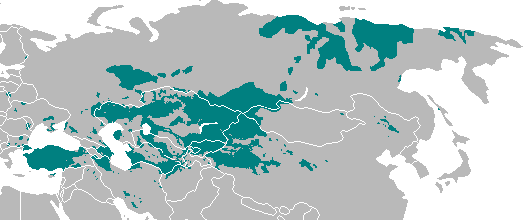This is an old revision of this page, as edited by Dbachmann (talk | contribs) at 18:00, 15 March 2008 (not in Siberia). The present address (URL) is a permanent link to this revision, which may differ significantly from the current revision.
Revision as of 18:00, 15 March 2008 by Dbachmann (talk | contribs) (not in Siberia)(diff) ← Previous revision | Latest revision (diff) | Newer revision → (diff)Including the Russian Far East, the population of Siberia numbers just above 40 million people. As a result of the 17th to 19th century Russian conquest of Siberia and the subsequent population movements during the Soviet era, the demographics of Siberia today is dominated by native speakers of Russian. There remain a considerable number of "indigenous" groups, between them accounting for roughly 10% of total Siberian population. Many of the individual groups are close to extinction, or in the process of assimilation ("Russification").
Overview
Further information: Uralo-Siberian languagesClassifying the diverse population by language, it includes speakers of the following language families (number of speakers reflect the 2002 Russian census):
- "Ural-Altaic"
- Chukotko-Kamchatkan (some 25,000 speakers)
- Nivkh (some 5,000 speakers)
- Eskimo-Aleut (some 2,000 speakers)
- Ket (some 1,400 speakers)
Simplified, the indigenous peoples of Siberia listed above can be put in three groups,
- Uralic
- Altaic
- Paleosiberian ("other")
Neither Altaic nor Paleosiberian has been proven to be a language family, a phylogenetic unit. Some approaches regard Altaic as an example of Sprachbund. It would be even more problematic to regard Paleosiberian as a genealogical unit. Here, these two terms are listed just to serve as portal-like starting points — without suggesting genetic considerations.
Uralic group
Further information: Uralic peoples
Altaic group
Turkic peoples
Further information: Turkic peoplesYou must add a |reason= parameter to this Cleanup template – replace it with {{Cleanup|reason=<Fill reason here>}}, or remove the Cleanup template.
The most important examples for Shamanism in Siberia are the North Siberian Turkic peoples (Yakuts and Dolgans), and South Siberian Turkic groups (Tuvans etc.). Some shamanistic elements are retained also at some Central Asian Turkic peoples.

Mongolic group
Main article: BuryatsThe Buryats number approximately 436,000, which makes them the largest ethnic minority group in Siberia. They d are mainly concentrated in their homeland, the Buryat Republic, a federal subject of Russia. They are the northernmost major Mongol group.
Buryats share many customs with their Mongolian cousins, including nomadic herding and erecting huts for shelter. Today, the majority of Buryats live in and around Ulan Ude, the capital of the republic, although many live more traditionally in the countryside. Their language is called Buryat.
Tungusic group
Further information: Tungusic peoplesThe Evenks live in the Evenk Autonomous Okrug of Russia.
"Paleosiberian" group
Main article: Paleosiberian languages
Literature
- Rubcova, E.S.: Materials on the Language and Folklore of the Eskimoes, Vol. I, Chaplino Dialect. Academy of Sciences of the USSR, Moskva * Leningrad, 1954
- Menovščikov, G. A. (= Г. А. Меновщиков) (1968). "Popular Conceptions, Religious Beliefs and Rites of the Asiatic Eskimoes". In Diószegi, Vilmos (ed.). Popular beliefs and folklore tradition in Siberia. Budapest: Akadémiai Kiadó.
- Barüske, Heinz: Eskimo Märchen. Eugen Diederichs Verlag, Düsseldorf and Köln, 1969.
- Merkur, Daniel: Becoming Half Hidden / Shamanism and Initiation Among the Inuit. Acta Universitatis Stockholmiensis / Stockholm Studies in Comparative Religion. Almqvist & Wiksell, Stockholm, 1985.
- Kleivan, I. and Sonne, B.: Eskimos / Greenland and Canada. (Series: Iconography of religions, section VIII /Arctic Peoples/, fascicle 2). Institute of Religious Iconography • State University Groningen. E.J. Brill, Leiden (The Netherland), 1985. ISBN 90-04-07160-1.
References
- The New Encyclopædia Britannica, 15th Edition. (1977). Vol. II, p. 396. ISBN 0-85229-315-1.
See also
- Demographics of Siberia
- First All Union Census of the Soviet Union
- Indigenous people
- List of ethnic groups
- Pomors
- Kola Norwegians
- Uralic languages
- Finno-Ugric languages
- Shamanism in Siberia
- List of indigenous peoples of Russia
- List of small-numbered indigenous peoples of Russia
External links
- Russian Association of Indigenous Peoples of the North
- UNESCO Red Book on endangered languages: Northeast Asia
- Endangered Uralic Peoples
- Minority languages of Russia on the Net
- The Red Book of the peoples of the Russian Empire
- Survival International article about the Northern indigenous peoples
- L'auravetl'an Indigenous Information Network by Indigenous Peoples of Russia
- Template:Ru icon В погоне за малыми, an article about treatment of minorities in the Russian Empire, Kommersant-Money, October 25, 2005